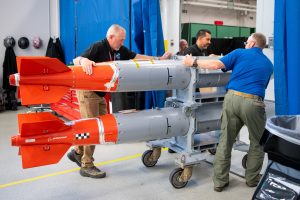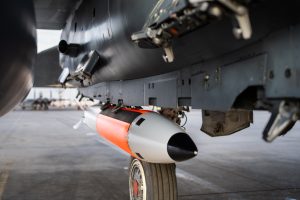Sandia National Laboratories and the nuclear security enterprise have achieved a significant milestone for the nation's nuclear deterrence program with the completion of the last production unit of the B61-12 nuclear gravity bomb in December. While the last production unit is now complete, the B61-12 program is still producing spare components and pursuing program closeout activities into fiscal year 2026.

"It's a tremendous accomplishment," said Rich Otten, a Sandia senior manager involved in the design and production aspects of the B61-12 Life Extension Program. "For more than a decade, people have poured their time, effort and careers into making this a reality."
The completion of the last production unit is the result of collaborative partnerships among the Sandia and Los Alamos national laboratories, the Kansas City National Security Campus, Pantex Plant, Y-12 National Security Complex, Savannah River Site, the National Nuclear Security Administration and the U.S. Air Force, along with numerous vendors.
The B61 went into service in 1968. As part of this life extension program, most older modifications of the B61 have been replaced to extend the weapon's service life by at least 20 years resulting in a high reliability stockpile.
Sandia is the design and engineering laboratory for the nonnuclear components in the life extension program and the systems integrator for the B61-12. As systems integrator, Sandia is responsible for ensuring all systems and subsystems work together seamlessly.
Otten added that production is complex, and significant effort went into ensuring aircraft compatibility, especially as changes were made to delivery platforms.
Stockpile sustainment

With full system production complete, the B61-12 is now fully a stockpile system.
"We want to take time to recognize and celebrate the last production unit," said Scott Klenke, a Sandia senior manager overseeing stockpile sustainment. "This is just the beginning of our efforts at Sandia to make sure the B61-12 is sustained and maintained appropriately. It's a critical element to ensure we have a strong and viable deterrent."
Sandia also produced several components delivered to the Kansas City National Security Campus and Pantex Plant to enable full-scale production.
Klenke said work will continue across the nuclear security enterprise, NNSA and the Department of Defense to ensure stockpile surveillance activities on the B61-12 run smoothly. These activities include randomly selecting units, disassembling them at the Pantex Plant and testing components at Sandia's Weapons Evaluation Testing Laboratory.
Additionally, some units will be used to support surveillance flight tests. Testing data from surveillance, laboratory and flight activities are used to support the system's annual assessment report, which underpins the Labs director's letter asserting the safety, reliability and performance of weapons in the stockpile.
"These surveillance and assessment activities continue until retirement and until the last unit is dismantled," Klenke said.
Crews carry out various flight tests on the B61-12 at Nellis Air Force Base and at the Tonopah Test Range in Nevada. (Video by Sandia National Laboratories)






